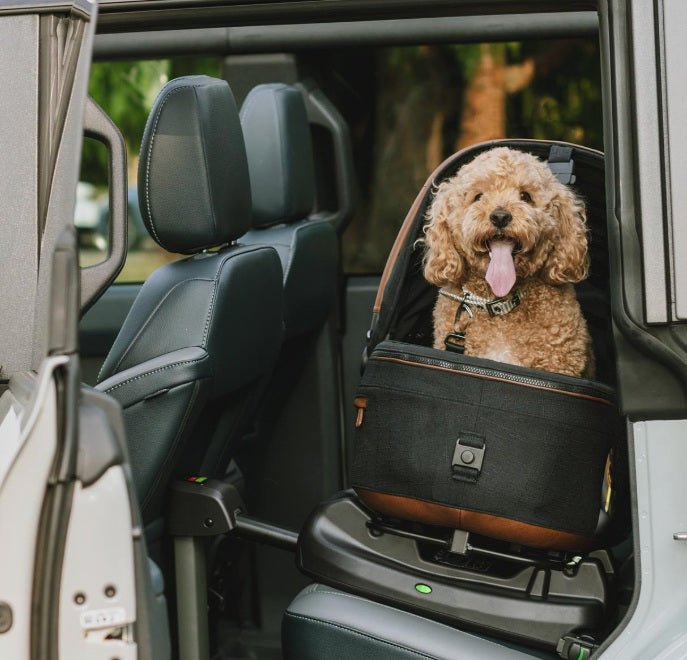
Sadursmju testēti suņu un kaķu ceļošanas līdzekļi – Kam ir vērts uzticēties?
Lukuaika: 3 min
Lukuaika: 3 min
Suns automašīnas aizmugurējā sēdeklī ir drošības jostas siksnas. Atbilstoši drošības līdzekļi nodrošina, ka mājdzīvnieks paliek vietā arī straujas bremzēšanas gadījumā. Daudzi mājdzīvnieku īpašnieki vēlas pārliecināties, ka mīļais spalvainais draugs ceļo automašīnā tikpat droši kā cilvēki. Praktiski tas nozīmē mājdzīvnieka piesprādzēšanu ar drošības jostas siksnām vai ievietošanu transportēšanas kastē. Diemžēl mājdzīvnieku ceļošanas drošības testēšana joprojām ir nepilnīga: piemēram, Somijā un ES nav oficiālu drošības standartu mājdzīvniekiem paredzētajām drošības ierīcēm. Daudzas tirgū pieejamās siksnas, būri un kastes tiek reklamētas kā “drošas” bez pienācīgiem testiem, tāpēc patērētājam ir grūti zināt, kuri produkti patiešām iztur avārijas situāciju. Šo nozari jau ilgu laiku raksturo kā tādu kā “mežonīgo rietumu” drošības ziņā.
Par laimi situācija uzlabojas. Pēdējos gados daži ražotāji paši ir veikuši neatkarīgus sadursmes testus saviem mājdzīvnieku pārvadāšanas līdzekļiem, un, piemēram, ASV Center for Pet Safety (CPS) un Zviedrijā RISE ir sākuši publicēt testu rezultātus. Daudzi neatkarīgi testi ir pierādījuši, ka parastās suņu drošības siksnas vai vājās plastmasas pārvadāšanas kastes neiztur sadursmes slodzi – sliktākajā gadījumā mājdzīvnieks var atdalīties no līdzekļa un ar spēku izsviesties uz priekšu, radot dzīvībai bīstamu situāciju gan sev, gan pasažieriem. Piemēram, dažus kilogramus smagam sunim sadursmes svars 50 km/h ātrumā ir pat 40 reizes lielāks par tā paša svaru. Bez īpašas projektēšanas un testēšanas aprīkojums var neatbilst reālai avārijas situācijai.
Tā kā oficiālu mājdzīvnieku drošības standartu nav, progresīvākie ražotāji ir pievērsušies bērnu drošības sēdeklīšu standartiem. Jaunākais ANO bērnu drošības sēdeklīšu regulējums ir ECE R129 (pazīstams arī kā "i-Size" standarts). Tas ir stingrāks par iepriekšējo ECE R44/04 standartu (piemēram, prasības ietver sānu sadursmes aizsardzību) un ir kļuvis par sava veida "zelta standartu" arī mājdzīvnieku pārvadāšanas risinājumiem. Pēdējos gados daži mājdzīvnieku produktu ražotāji ir sākuši testēt savus produktus atbilstoši ECE R129 prasībām. Piemēram, daži drošības siksnu un kastu ražotāji ir kalibrējuši savus sadursmes testus šim standartam, kas nozīmē, ka produkts iztur pēkšņas palēnināšanās un slodzes tikpat prasīgi kā bērnu drošības sēdeklis. Kad produkts atbilst ECE R129 prasībām, tas pierādīti iztur tādas pašas apstākļus kā bērnu sēdeklīši sadursmē – tas sniedz papildu drošību mājdzīvnieku īpašniekam.
ECE R129 standarta testos tiek izmantota automašīnas sadursmes testa iekārta un dzinamais slodzes tests: produkts tiek piestiprināts pie automašīnas un pakļauts pēkšņai apstāšanās simulācijai sadursmes laikā. Testos tiek izmantotas dažāda izmēra suņu vai kaķu modeļlelles, ar kurām simulē dažāda svara mājdzīvniekus. Novērtēšanā tiek vērots, vai lelle (t.i., "mājdzīvnieks") droši paliek vietā siksnās vai pārvadāšanas kastē, kā arī cik lielas spēka ietekmes ir uz mājdzīvnieku un cilvēkiem sadursmes situācijā. ECE R129 prasa, lai ierīce nesaplīst un neatdalās no stiprinājumiem sadursmē, tādējādi mājdzīvnieks ir labāk aizsargāts un pārējie pasažieri drošībā. Turklāt standarts prasa efektīvu sānu sadursmes aizsardzību un netoksiskas, ugunsdrošas materiālu konstrukcijas.
ISOFIX stiprinājums ir mūsdienīgas drošības sēdekļa sistēmas būtiska daļa: tas nozīmē, ka drošības ierīce tiek tieši pieslēgta ISOFIX enkuriem automašīnas rāmī, nevis izmantojot atsevišķu drošības jostas stiprinājumu. Daudzos ECE R129 līmeņa mājdzīvnieku pārvadāšanas līdzekļos tiek izmantoti ISOFIX stiprinājumi un bieži arī augšējais enkurs (top tether) kā papildu stiprinājums. Kvalitatīvs, pareizi uzstādīts pārvadāšanas būris paliek vietā sadursmes laikā un netiek izmests – tādējādi tas aizsargā gan mājdzīvnieku, gan citus pasažierus.
Gan suņu, gan kaķu īpašniekiem sadursmes testēti ceļošanas līdzekļi sniedz skaidru mieru. Izvēloties produktu, kas testēts saskaņā ar ECE R129 standartu, Jūs varat paļauties, ka tas ir izgājis ārkārtīgi prasīgus testus un tos veiksmīgi izturējis. Šāda aprīkojuma mērķis ir aizsargāt mājdzīvnieku – tāpat kā bērnus drošības sēdeklī – pat smagās sadursmēs. Sadursmes testēta pārvadāšanas būris vai drošības josta, visticamāk, paliks neskarts un noturēs mājdzīvnieku drošībā, būtiski samazinot traumu risku. Tajā pašā laikā tas novērš mājdzīvnieka izmešanu salonā un papildu draudu radīšanu cilvēkiem.
Kopsavilkums: Lai gan mājdzīvnieku drošības līdzekļiem vēl nav oficiālu standartu, produkti, kas testēti saskaņā ar ECE R129 normu, pašlaik pārstāv labāko pieejamo drošības līmeni. To konstrukcija un stiprināšanas sistēma ir pierādīta kā izturīga reālos sadursmes apstākļos. Izvēloties savam sunim vai kaķim sadursmes testētu drošības līdzekli, Jūs varat pamatoti paļauties, ka esat darījis visu saprātīgo sava mājdzīvnieka drošības labā. Tā ir investīcija, kas sliktākajā gadījumā var glābt Jūsu mājdzīvnieka (un arī cilvēku) dzīvību.
Atsauces
Center for Pet Safety – CPS Certified produktu saraksts ar sadursmes testētiem produktiem
https://www.centerforpetsafety.org/cps-certified/
Center for Pet Safety – Testu rezultāti un pētījumi par mājdzīvnieku ceļošanas drošību
https://www.centerforpetsafety.org/test-results/
Center for Pet Safety – Vispārīga informācija par organizāciju un testēšanas metodēm
https://www.centerforpetsafety.org
KIRO7 – Pētījums par produktu neveiksmēm mājdzīvnieku sadursmes testos
https://www.kiro7.com/news/investigates/investigates-hundreds-products-fail-four-legged-crash-dummies-tests/Y3FDEH45YZE55EFWO7KTNI47TQ/
Tavo Maeve mājdzīvnieku aizsardzības sistēma – produkts, kas testēts atbilstoši ECE R129 standartam
https://www.thesprucepets.com/best-dog-car-seats-4798624
Tavo Dupree II vakuuma pārbaudīts mājdzīvnieku nesējs – testēts atbilstoši ECE R129 un ISOFIX standartiem
https://www.kidslandusa.com/tavo-pets-dupree-ii-carry-on-pet-car-seat/
Smart Bark – Raksts par nepilnībām mājdzīvnieku ceļošanas drošības testos
https://www.smartbark.co.uk/post/best-dog-car-seats
Free delivery for all 99,00 € orders